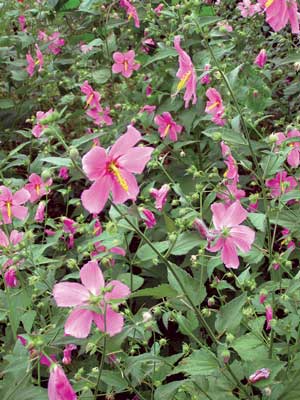
By Ken Moore
Flora Columnist
Driving through the center of campus on Cameron Avenue last week, I noticed hundreds of flowers of seashore mallow, Kosteletzkya virginica, stretching up over the stone wall next to Coker Arboretum’s arbor. The vivid pink of those flowers caused me to slow down for a brief closer look.
Here in the Piedmont, you will see this beautiful wildflower only in gardens. In the wild, it occurs in ditches and edges of brackish marshes and rivers along the coast from New York all the way down and around to coastal Texas.
Years ago, in the late 1970s, I was approaching the White Oak River bridge at the coastal town of Swansboro when I spied a ditch filled with a tall wildflower unknown to me. Using my trusty old Flora of the Carolina’s botanical key, I was excited to zoom in on seashore mallow.
Seeds collected from that ditch a month or so later were subsequently sown at the N.C. Botanical Garden. Resulting plants were observed for the next several years in the garden’s wildflowers beds. Surprisingly, seashore mallow, expected to require constant moist conditions, as in the wild, proved to be a vigorous, drought-tolerant perennial. So impressed were garden staff that they designated it the Wildflower of the Year in 1990. Since then, as a result of the garden’s seed distribution and plant sales, it has become a common garden plant in the area.
If you take a really close look at the pink flower, you will discover a central tube or cylinder of numerous stamens with pollen-covered anthers. Emerging from the center of the stamen tube is the stem, the style of the female pistil, which at the end splits into five globular stigmas eager to capture pollen from unsuspecting pollinating insects. This particular configuration of flower parts is characteristic of plants in the Malvaceae, the mallow or hibiscus family.
Plants along the arbor at Coker Arboretum are now past peak flowering, though the couple of plants below my deck are just now beginning to peak. It’s interesting that years ago seashore mallow flowered later. I remember flowering beginning after Labor Day and continuing right up to frost time. Perhaps this is another of those alterations in nature resulting from changes in our weather patterns.
The flowers have a habit of opening early in the morning and closing by midday on hot sunny days. They remain open into late afternoon on cloudy days and even on sunny days if the temperature is coolish.
If you’re traveling to the coast in the morning within the next week or two, look for seashore mallow along wet edges. And visit your favorite garden center to search it out for planting in your garden. I know there are some available at the Botanical Garden, where they will be a popular item at the big fall plant sale on Sept. 25.
Give your plant lots of room to grow. A single specimen can attain a height and spread of 6 feet. In addition to those beautiful flowers, you’ll enjoy all the butterflies and bees flitting about.
Email Ken Moore at flora@carrborocitizen.com.


